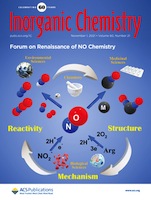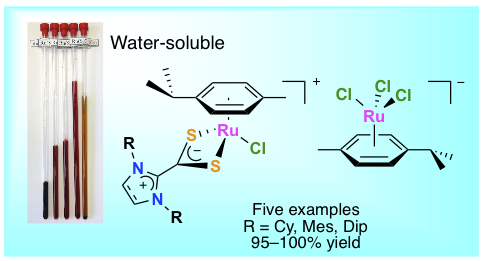"Synthesis, Characterization, and Biological Activity of Water-Soluble, Dual Anionic and Cationic Ruthenium-Arene Complexes Bearing Imidazol(in)ium-2-dithiocarboxylate Ligands"
Mohammed Zain Aldin, Guillermo Zaragoza, William Deschamps, Jean-Claude Didelot Tomani, Jacob Souopgui, and Lionel Delaude
 |
source: Inorganic Chemistry
year: 2021
volume: 60
first page: 16769
last page: 16781
doi: 10.1021/acs.inorgchem.1c02648
|

Abstract: An efficient synthetic protocol was devised for the preparation of five cationic ruthenium-arene complexes bearing imidazol(in)ium-2-dithiocarboxylate ligands from the [RuCl2(p-cymene)]2 dimer and 2 equiv of an NHC·CS2 zwitterion. The reactions proceeded cleanly and swiftly in dichloromethane at room temperature to afford the expected [RuCl(p-cymene)(S2C·NHC)]Cl products in quantitative yields. When the [RuCl2(p-cymene)]2 dimer was reacted with only 1 equiv of a dithiolate betaine under the same experimental conditions, a set of five compounds with the generic formula [RuCl(p-cymene)(S2C·NHC)][RuCl3(p-cymene)] was obtained in quantitative yields. These novel, dual anionic and cationic ruthenium-arene complexes were fully characterized by various analytical techniques. NMR titrations showed that the chelation of the dithiocarboxylate ligands to afford [RuCl(p-cymene)(S2C·NHC)]+ cations was quantitative and irreversible. Conversely, the formation of the [RuCl3(p-cymene)]- anion was limited by an equilibrium, and this species readily dissociated into Cl- anions and the [RuCl2(p-cymene)]2 dimer. The position of the equilibrium was strongly influenced by the nature of the solvent and was rather insensitive to the temperature. Two monometallic and two bimetallic complexes cocrystallized with water, and their molecular structures were solved by X-ray diffraction analysis. Crystallography revealed the existence of strong interactions between the azolium ring protons of the cationic complexes and neighboring donor groups from the anions or the solvent. The various compounds under investigation were highly soluble in water. They were all strongly cytotoxic against K562 cancer cells. Furthermore, with a selectivity index of 32.1, the [RuCl(p-cymene)(S2C·SIDip)]Cl complex remarkably targeted the erythroleukemic cells vs. mouse splenocytes.
[Full Text] [<< Previous Article] [Back to the List of Publications] [Next Article >>] l.delaude@ulg.ac.be